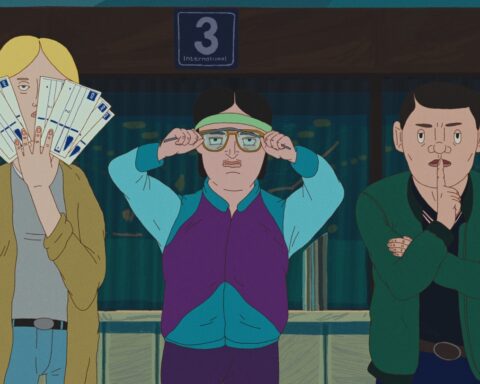On my last day at TIFF, inspiration grabbed me one final time before calling it a day. I had been trying throughout the fest to score an interview with Rob Stewart, director of Revolution. I gave it one more try before heading home after the screening. Turns out I was successful…but not for another four months.
When I was growing up in the ’70s, fears of nuclear annihilation filled the media. In the ’80s I recall predominant messages about ozone depletion. In the ’90s global warming took over as the main threat to human life on earth. Before my time, it was the Cold War and before that, a real one that threatened us all. It’s no surprise, then, that I was a little desensitized to the message in Stewart’s second feature film, Revolution. After all, if we’re killing the oceans, the rest of us aren’t far behind.
Although there’s urgency and passion in the film, in an interview, Stewart is a model of serenity. Part of that might be due to his having more than broken even, ahead of the film’s release—but I doubt it. His message is backed by scientific fact—or at least that’s what the experts in Revolution tell us. Carbon, dumped into the atmosphere by humans, eventually ends up in the oceans, where it is causing acidification, which in turn is displacing oxygen on a grand scale. Every living thing in the ocean depends on oxygen. All five known major extinctions on the planet were preceded by ocean acidification.
I saw Revolution on the final Sunday at TIFF and showed up at the last minute to a packed house. The only seat left was beside two reserved spots, which happened to be taken by Stewart’s parents. I made sure to congratulate them afterwards on having raised such an incredible son. Most of the house stayed for a lively Q&A and the film deservedly earned the Peoples’ Choice runner-up award.
Stewart’s memoir, Save the Humans, covering his life up to the completion of Revolution, was recently published by Random House. I love reading about how films are made, so learning how his first doc, Sharkwater, came to be was gratifying. The trigger for production was a signed release from the Sea Shepherd Conservation Society’s eco-warrior leader, Paul Watson. Stewart bull-headedly went deep into debt to rent a shoulder-mounted HD camera (new at the time) and simply accompanied Watson to the South Atlantic. There was no story arc figured out ahead of time—he followed the puck. Chances were pretty good that something interesting was going to happen, but what most impressed me is that Stewart simply followed his passion for sharks, trusting that at the end of the day it would all make sense and he’d be able to recoup. A film made simply on principle. Kudos.
After years of speaking engagements all around the planet and over 50 awards, Stewart had one crowning achievement: Sharkwater was released in China, ground zero for shark fin soup, the making of which is the main threat to his beloved creatures. But the experience was bittersweet. During a Q&A session, a woman asked him why we should bother saving the sharks if all other species in the oceans are slated for extinction this century. No kidding, this is what some scientists are saying.
Just as saving the sharks drove Sharkwater, saving the oceans is driving Revolution. While Stewart doesn’t like attaching labels like “activist” or “filmmaker” to help define himself, it is certainly true that the causes he supports come first and the films are driven by them. There are several calls to action in the films and the book. I suspect these are aimed at younger audiences, but I feel a chill every time I see one in a film. I’d like to think that audiences are sophisticated enough that, if motivated, they will seek out the info without being urged to do so.
In Revolution Stewart set out to spread awareness about just exactly how badly humans are fucking up ocean environments and what the imminent consequences are for all life on earth. This is an urgent message. Thanks to the massive success of Sharkwater, Stewart was able to raise a significant amount of money initially. Given his prior success in leveraging interest by applying a novel new technology (HD), Stewart attempted to repeat the success, this time with 3-D. But after word got out that the new film had a green streak, the bulk of the financing fell through. Stewart humbly summed up the false start in 3-D this way: “That was when I had five million dollars.”
Relieved of such a heavy financial burden, Stewart then resolved to use another developing technology, the digital SLR. Revolution was shot with Canon 5Ds using modest handheld rigs. “For $700 I can have a Steadicam!” There was another luxury afforded by the change in finances: With fewer people pushing for a particular type of on-screen action, or completion by a certain date, time opened up for him. He spent four years travelling the world, in production.
The modest camera package also allowed for a different approach on the road. Stewart flew under the radar everywhere, without a single border-crossing incident. I was shocked to learn about his approach to audio. Everything was either recorded via the cameras built into a measly 8-bit system or through an external recorder placed near the subjects. Either way, the audio was recorded blind. The specific gear used did not allow for monitoring the levels or quality. Since the production of Revolution, the technology has changed, but even so, it’s uncommon for filmmakers to simply trust that things will be OK. But that’s exactly what Stewart did and it worked out fine.
Acceptance of the possibility that humans might devastate life as we know it on earth allowed Stewart to concentrate on a couple of creatures that intrigue him. In Save the Humans, he describes a passion for beings that have evolved as specialists. One such creature, called Pfeffer’s flamboyant cuttlefish, is a chameleon-like poisonous invertebrate with multiple tentacles and an extendable appendage that shoots out quickly to snap up unsuspecting prey. This, his favourite muck-dweller, is possibly situated to become one of the prominent surviving species should humans succeed in wiping out the majority of life underwater.
The other possibility considered is the rotating life cycle of the lynx. Lynx prey primarily on rabbits. The success of their hunting endeavours results in a happy population and more babies. The population expands beyond the resources available to them and the rabbits are hunted almost out of existence, resulting in starvation for much of the lynxes. The lynx population shrivels, leaving the rabbits to rebound, which they do, and the cycle repeats over and over again. The thought of such an example in a film like Revolution occurred to me as a bit morbid, so I asked why it was included. “Because that’s what happens.”
Acceptance doesn’t mean complacency, though; hence the film’s title. The larger call to action is not simply to any organisation or specific cause that Stewart supports. It’s a wake-up call for everyone to do their own unique part in turning the momentum around.
There were a lot of positive role models shown in Revolution. One stirring example of this was a Bavarian youth activist, Felix Finkbeiner, founder of Plant-for-the-Planet, who invited the ministers and heads of state of all 194 attending countries at the UN Climate Conference in Mexico to plant a tree. One of Finkbeiner’s original goals was to plant a million trees in every country.
“We have to save our own future,” says Finkbeiner in the film. “We tried to get the people inside the conference to talk. Sure, these conferences are important, because without them we cannot get a world contract. But just talking without any action won’t save our future.” The TIFF audience broke into applause at this point, only to have their hearts crushed later on. As the conference winds down without any evidence of progress, Finkbeiner is amongst many protesters escorted off the grounds by security for protesting outside the main entrance. A telling moment is when a security guard man-handles Finkbeiner, which Stewart captures on camera. The guard then calls out to the crowd, “Who’s the guardian of this boy?”
As a counterpoint to this unsavoury anecdote, the film later shows Stewart visiting Saipan to witness the signing into law of a ban on shark-finning. It had been triggered after a sixth-grade class, inspired by Sharkwater, became politically active and successfully lobbied their government to become only the second legally constituted entity to enforce the ban. Here’s what one of the students had to say afterwards: “I am so proud because we are so young, but we have accomplished a lot of things. Big things.”
Stewart’s acceptance of the possibility of an impending oceanic collapse without attachment or hyperbole left me wondering what’s on his bookshelf. Presently he’s mostly reading about physics. He’s looking to the future for the next cause or film, but hasn’t been struck with inspiration yet.
In Save the Humans, Stewart describes how he came to cinematography via stills photography. He is self-taught and read the manual to the HD camera in transit to his first shoot during Sharkwater. Given how stunning his footage is, I was curious about how participating in the post production process had influenced his shooting skills. The answer surprised me because what he described in the book showed a lack of technical savvy. What he learned in post was not how to shoot, but what to shoot. The story in the first film didn’t evolve until well into the editing process. He was attempting to make a slow-paced, artsy film, not a point-of-view documentary. He only arrived at the use of himself as the central voice after being urged by his mentors. The film went through 97 edits. Having been a self-conscious and chubby child, starring in his own film was not a natural choice. I wondered if he’d accepted being front and centre on screen. He has—now, he always makes sure to get the shots of himself in every location.
I was so inspired by Save the Humans that I brought it along with me for Stewart to sign for my son. He wrote, “Jake, thanks for changing the world.” At first I thought the statement was a bit presumptuous. And then it sank in. What I think might not matter so much. What works is what counts.
The core message of Revolution is this: Humanity is at the crossroads. Here are the options and the consequences, both positive and negative. Choose.
Can documentaries really change the world? Sure they can. Revolution opens theatrically on 50 screens across Canada in April.










